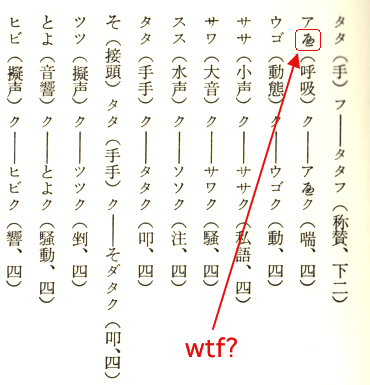A○gu
So I'm herp derping my way through Nihongo gogengaku no hōhō 日本語語源学の方法 ("Methods of Japanese etymology") by Yoshida Kanehiko 吉田金彦 when, in a list of verbs derived from words signifying emotional or subjective conditions (情態言を語基とするもの), I come across this:

Given the kanji, 喘, I deduce that the word must be a non-voiced antecedent to the modern aegu, i.e. aheku. What I don't know is why the /he/ is being represented by that hentaigana (a cursive version of 遍) instead of the katakana ヘ or hiragana へ.
Then I realize that I don't know why Yoshida is using both hiragana and katakana in his charts in the first place. (It's not key to his argument, and I'm skimming.) So I flick back a few pages and learn that he is using hiragana for type B (乙) vowels and katana for type A (甲) vowels and vowels with no (known) A/B distinction.
Now, the /e/ in aegu was originally type B, as any fule kno. So the hentaigana represents hiragana. And when a type A /he/ appears in the charts, it is represented by what I take to be the katakana: ヘ. I can't find any other examples of type B /he/, but since Yoshida doesn't have anything in particular to say about /aheku/ in his commentary, I suppose that he is using the hentaigana because the hiragana is almost identical to the katakana and he wants the difference to be noticeable.
And Yoshida got an editor and typesetter to sign off on this in 1976, too. That strikes me as impressive — or was/is it a standard academic practice?
![[No-sword]](http://no-sword.jp/images/site/no-sword_banner.jpg)



Paul D.:
That's a pretty cool use of hentaigana, actually.